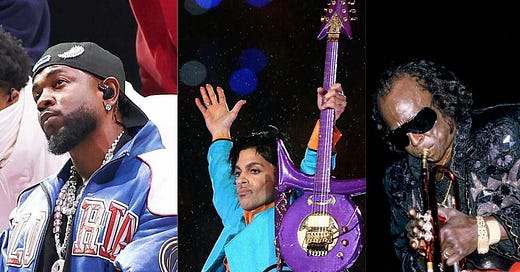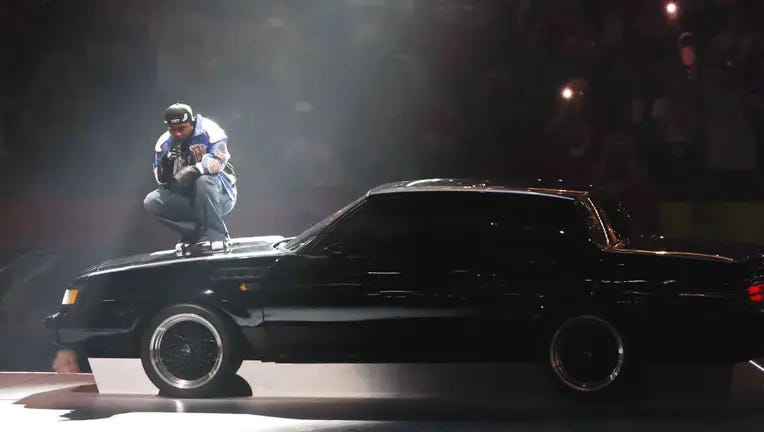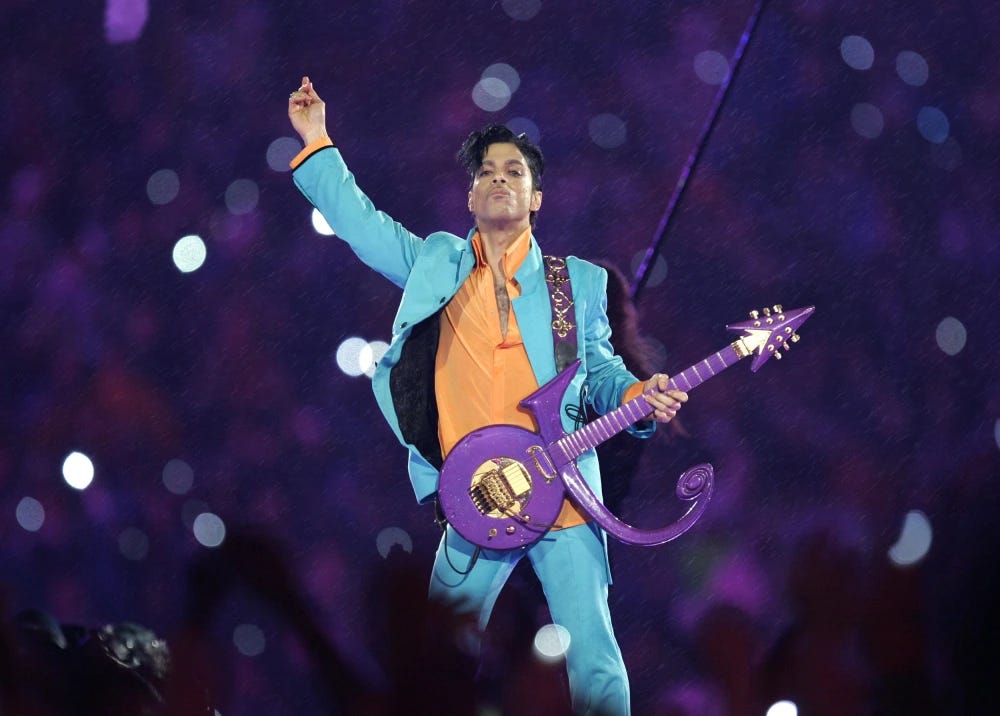Stand On Business: Kendrick Lamar, Prince, Miles, and What It Means To Not Look Back
Lamar leaned heavily on his latest album, "GNX," for his Super Bowl Halftime performance. This reflects on his desire to look forward, much like Prince and Miles Davis before him.
“Always look ahead, but never look back.” - Miles Davis
In September 2024, Kendrick Lamar announced he was headlining the 2025 Super Bowl Halftime show. Right from the start it became one of the most anticipated halftime shows in recent memory. The 22-time Grammy winner was riding the wave of his victory in a rap battle against fellow rap superstar Drake. “Not Like Us,” Lamar’s final diss aimed at Drake, was well into its 25-week reign at No. 1 on the Billboard Rap Charts.
Days before the Super Bowl, the Pulitzer Prize winner told Apple Music to expect “storytelling” in his presentation, setting the tone for a unique performance. Rather than delivering a retrospective of his hit records, Lamar’s Super Bowl Halftime experience, produced by his pgLang multi-media company, was a thoughtfully curated show featuring mostly songs he released in 2024. Nine of the 12 songs performed or referenced in the setlist were either from last year’s battle with Drake or his latest album GNX, released in November.
Nearly every previous halftime headliner performed their most well-known songs. Last year, R&B legend Usher performed a litany of his greatest hits, despite dropping a new album, Coming Home, two days earlier. Lamar had his fair share of time-tested hit records to pick for his Super Bowl setlist. Songs like “Swimming Pools (Drank),” “m.A.A.d. city,” “Alright,” and “LOYALTY.,” certainly would’ve been safer choices that casual Lamar fans would immediately recognize.
(Kendrick Lamar performing atop at Buick GNX while performing the “Apple Music Super Bowl LIV Halftime Show” at the Caesars Superdome in New Orleans. Photo Credit: Cindy Ord/Getty)
But Lamar didn’t do that. He did what he always does…something else.
The performance was an ode to subverting the expectations and limitations that come with being a Black performer in America. Oscar-nominated actor Samuel L. Jackson portrayed Uncle Sam, condemning Lamar for not following the status quo each time the Compton MC ran through GNX tracks like “Squabble Up,” “Man at the Garden,” “Peekaboo,” and “Luther” featuring SZA while encouraging him for singing well-known crossover jams like Oscar-nominated smash “All the Stars.”
Although Lamar did perform three of his biggest hits, “HUMBLE.,” “DNA.,” and “All The Stars” with SZA, it was only because they played a role in the larger, allegorical narrative. The performance was captivating, visually stimulating, and ultimately, maybe even purposely, polarizing. While some fans lauded the performance as a masterful display of rap and hip-hop, others lambasted it as boring and underwhelming.
Certainly, Lamar had to know that all but exclusively highlighting his new project (including a longer version of his GNX promotional snippet), was a gamble. But this isn’t the first time he’s rolled the dice on new material. Since his To Pimp a Butterfly campaign a decade ago, nearly every all of his TV performances incorporated unreleased songs/verses (2016 Grammy Awards), or verses that fans would hear later on other projects (BET Awards, Colbert Report, Saturday Night Live, The Tonight Show with Jimmy Fallon, 2018 Grammy Awards).
As Lamar told Apple Music’s Ebro Darden and Nadeska Alexis in his Super Bowl press conference/interview, he had no desire to reminisce. “I love being present,” Lamar told Apple Music. It’s very hard for me to live in the past. I respect the past, but living in the now, and being just locked into how I feel and the energy I have now, that’s the L.A. energy for me.”
Lamar’s declaration of his forward-thinking ideology mirrors the modus operandi of two departed music icons - Prince and Miles Davis. All three men are known for their innovative decision-making, proficiency in reinvention, and affinity to challenge themselves and their fans.
Prince was perhaps the most prolific artist in contemporary music history (39 studio albums in 40 years). He was notorious for switching his styles (both sonically and aesthetically) from one project to the next. Prince didn’t just have albums; he had eras. One moment, he’s wearing Black bikini briefs and thigh-high boots while fusing new wave with funk for his Dirty Mind album. The next moment, he’s wearing jean jackets and eye-glasses as he mixes Bay Area funk with rock for Sign O’ The Times.
(Prince performing during the “Super Bowl XLI Halftime Show” at Dolphin Stadium in Miami Gardens. Photo Credit: Chris O'Meara / AP)
His Royal Badness often worked on several albums simultaneously. Purple Rain, released in June 1984, was one of the biggest-selling albums of the decade. But instead of coasting on its success, Prince completed its follow-up, Around the World in a Day, before the end of the year, and released it in April 1985, just two weeks after the Purple Rain tour concluded. Prince needed to challenge himself and the audience with each new project, and for that reason, he seldom lingered on older material when performing live.
During Prince’s prime, his tour setlists seldom ventured beyond a two-to-three album radius. It’s like he was over it as soon as it was completed. The Oscar winner also held his latter work in the same regard as his imperial era. In 2014, talk show host Arsenio Hall asked Prince what was his favorite song from his catalog. Prince responded with “The Breakdown,” a track from his then-newly released album, Art Official Age.
“I don't live in the past,” Prince once said in a 1985 interview. “I don't play my old records for that reason. I make a statement, then move on to the next."
Prince’s desire to look ahead was more a necessity for the late Miles Davis. The master trumpeter was arguably the biggest reason that so-called jazz penetrated the mainstream in a major way while influencing several generations of musicians of numerous genres.
Like Prince, Davis was incredibly prolific, releasing no less than 60 studio albums in his lifetime, all while setting the tone for the genre with nearly every release. In 1959, Davis’ Kind of Blue put modal jazz on the map on its way to becoming the biggest-selling jazz album ever with over five million copies sold. Ten years later, he turned the genre upside down with albums like In a Silent Way and Bitches Brew, ushering in a new sub-genre and musical movement; fusion.
Davis also had eras. The days of Kind of Blue saw him donning Brooks Brothers suits and a short, natural haircut. Later on, his afro grew in the late 1960s and early 1970s with his new hip, colorful clothes, and designer shades (punctuated by the influence of his one-time wife, future funk maven Betty Davis) reflecting the progressive, experiment times, paralleled by albums like Bitches Brew and On The Corner.
(Miles Davis performing at the 1973 Montreux Jazz Festival in Montreux, Switzerland. Photo Credit: David Warner Ellis/Redferns)
The idea of Davis repeating himself was so limiting, that he felt rehashing old material was a matter of life and death. According to his 2019 documentary, Miles Davis: Birth of the Cool, he often told many of his collaborators and cohorts, “If I look back, I’ll die.” Oddly enough, in 1991, Davis died three months after performing songs from his back catalog in their original Gil Evans arrangements, captured for the album Miles & Quincy: Live at Montreux.
Lamar, Prince, and Davis (all Geminis, by the way) share a rare artistic trait—the unwavering commitment to the present. Choosing this path not only challenged them as artists but also the audience. Lamar wasn’t afraid of backlash after not including more hits at the Super Bowl. Prince cared more about making new music than he did about his record company dropping greatest hits packages. Davis may have literally been allergic to spending too much time keeping a song in his setlist.
What’s amazing about Lamar’s music and mindset for live performing is his refusal to be defined by nostalgia. Like Prince and Davis, this method keeps his music alive. They see/saw themselves not as relics of past glory but as ever-evolving expressions of creativity. In doing so, they remind us that true artistry isn’t about looking back—it’s about what comes next.
THANK YOU FOR READING! If you enjoyed this piece, please subscribe to my page and share the piece on social media. Thanks again, and stay tuned for more!








You ate this! This is exactly how I saw it! Miles especially HATED repeating himself or playing his old stuff. It was indeed a gamble for Kendrick but the performance for me was amazing it had a cinematic feel to it and will be more appreciated as the years go by. He chose his art > the expectation of the public.